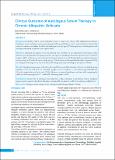Please use this identifier to cite or link to this item:
https://hdl.handle.net/20.500.14356/1626Full metadata record
| DC Field | Value | Language |
|---|---|---|
| dc.contributor.author | Karn, Dharmendra | - |
| dc.contributor.author | KC, Shekhar | - |
| dc.date.accessioned | 2023-05-16T10:50:05Z | - |
| dc.date.available | 2023-05-16T10:50:05Z | - |
| dc.date.issued | 2017 | - |
| dc.identifier.citation | KarnD., & KCS. (2017). Clinical Outcome of Autologous Serum Therapy in Chronic Idiopathic Urticaria. Journal of Nepal Health Research Council, 15(1). https://doi.org/10.33314/jnhrc.v15i1.975 | en_US |
| dc.identifier.issn | Print ISSN: 1727-5482; Online ISSN: 1999-6217 | - |
| dc.identifier.uri | http://103.69.126.140:8080/handle/20.500.14356/1626 | - |
| dc.description | Original Article | en_US |
| dc.description.abstract | Abstract Background: Quality of life in chronic idiopathic urticaria is hampered as efficacy of H1-antihistamines is limited. Autologous serum containing tolerance-generating anti-idiotype antibodies is a novel and cost-effective therapy. This study was conducted to evaluate the efficacy of autologous serum therapy (AST) among chronic urticaria patients with autologous skin prick test positive and negative status. Methods: Untreated 102 patients of chronic urticaria were enrolled in a non-randomized interventional study. Patients were categorized into two groups based on autologous serum skin prick test as test positive (ASST +) and test negative (ASST -). Patients were then treated with intramuscular injection of 0.05ml per kg body weight of autologous serum weekly for 10 weeks. Urticaria activity scoring (UAS) tool was used for quantification of the symptoms. Weekly recording of UAS (range: 0-42) was made before the therapy (baseline) and during the therapy for 10 weeks. Results: Significant improvement with AST in the mean UAS was noted from baseline to 10 weeks in both the group of patients (14.6 ± 6.3 and 10.2 ± 5.1 for ASST+ group ; 16.9 ± 7.8 and 8.6 ± 4.8 for ASST- group; at baseline and 10 weeks, respectively (p-value for both <0.05)). However no statistical significance was found while comparing the efficacy of the therapy against ASST + and ASST - Groups (p-value > 0.05). Conclusions: Irrespective of autologous skin prick test results, autologous serum therapy showed significant improvement in patients with chornic idiopathic urticaria. AST can, thus, be an effective treatment modality for it. Keywords: Autologous serum skin prick test; autologous serum therapy; chronic urticaria | en_US |
| dc.language.iso | en | en_US |
| dc.publisher | Nepal Health Research Council | en_US |
| dc.relation.ispartofseries | Jan-April, 2017;975 | - |
| dc.subject | Autologous serum skin prick test | en_US |
| dc.subject | Autologous serum therapy | en_US |
| dc.subject | Chronic urticaria | en_US |
| dc.title | Clinical Outcome of Autologous Serum Therapy in Chronic Idiopathic Urticaria | en_US |
| dc.type | Journal Article | en_US |
| local.journal.category | Original Article | - |
| Appears in Collections: | Vol. 15 No. 1 Issue 35 Jan-Apr 2017 | |
Files in This Item:
| File | Description | Size | Format | |
|---|---|---|---|---|
| 975-Manuscript-1904-1-10-20170608.pdf | Fulltext Download | 219.29 kB | Adobe PDF |  View/Open |
Items in DSpace are protected by copyright, with all rights reserved, unless otherwise indicated.
